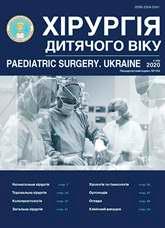Method of determining the degree of radicalism removal of pigment skin nevuses in children
DOI:
https://doi.org/10.15574/PS.2020.69.57Keywords:
children, surgical treatment, nevus, skin, primary tumorAbstract
Nevi are benign melanocytic tumors. Congenital melanocytic nevus is detected at birth or shortly after birth in 1% of infants. The nevus cells of simple nevican spread into the deep layers of the dermis. So incompletely excised nevus cells may at times continue to grow when the conventional excising technique is applied. A small pigment focus may therewith be detectable in the presence of a scar. These foci usually repeat the histological pattern of the primary nevus without any signs of malignization. The article presents an analysis of the data surgical approaches in the treatment nevus of the dermis. There are ways of improving surgical method of treatment of primary tumor based on research in the field of microarchitectonics of the skin.
The aim: to increase the effectiveness of determining the degree of radicalism of removal of pigmental nevi in children, taking into account the thickness of the hypoderma in different anatomical areas of the body.
Materials and methods of research. The work was carried out on the basis of the department of oncohematology of Vinnytsia Regional Children’s Clinical Hospital in the period from 2018 to 2020. Clinical distribution of features of surgical interventions in pigmented skin nevi involved analysis of data of medi cal cards of patients (120 documents). The age of patients of both sexes was between 3 and 16 years old. Patients with localization of pigmented neoplasms in different areas of the extremities (68 observations) and the trunk (52 children) were subject to analysis.
Conclusions. The proposed methodology for determining the radicalism of removing pigmented skin nevi by mathematically calculating the ratios of the areas of the removed tissues at the skin level and at the level of aponeurosis, taking into account the thickness of the hypoderma in different parts of the body, allow you to clearly calculate the individual parameters of the operating wound.
The research was carried out in accordance with the principles of the Helsinki Declaration. The study protocol was approved by the Local Ethics Committee of participating institution.
References
Castagna RD, Stramari JM, Chemello RML. (2017). The recurrent nevus phenomenon. An Bras Dermatol. 92(4): 531-533. https://doi.org/10.1590/abd1806-4841.20176190; PMid:28954104 PMCid:PMC5595602
Damsky WE, Bosenberg M. (2017). Melanocytic nevi and melanoma: unraveling a complex relationship. Oncogene. 36(42): 5771-5792. https://doi.org/10.1038/onc.2017.189; PMid:28604751 PMCid:PMC5930388
Fahradyan A, Wolfswinkel EM, Tsuha M et al. (2019). Cosmetically Challenging Congenital Melanocytic Nevi. Ann Plast Surg. 82(5S Suppl 4): 306-309. https://doi.org/10.1097/SAP.0000000000001766; PMid:30973837
Gantsev ShH, Lipatov ON, Gantsev KSh et al. (2017). Ploskokletochnyiy rak kozhi: vozmozhnosti hirurgicheskogo lecheniya. Effektivnaya farmakoterapiya. 36: 50–53.
Gantsev ShH, Yusupov AS. (2012). Ploskokletochnyiy rak kozhi. Prakticheskaya onkologiya. 13(2): 80–91.
Ghosh A, Ghartimagar D, Thapa S et al. (2018). Benign melanocytic lesions with emphasis on melanocytic nevi - A histomorphological analysis. Journal of Pathology of Nepal. 8: 1384-1388. https://doi.org/10.3126/jpn.v8i2.20891
Grebennikova OP, Prilepo VN. (2009). Onkologiya dlya praktikuyuschih vrachey. M: Avtorskaya Akademiya. 548-563.
Guegan S, Kadlub N, Picard A et al. (2016). Varying proliferative and clonogenic potential in NRAS-mutated congenital melanocytic nevi according to size. Exp Dermatol. 25(10): 789-796. https://doi.org/10.1111/exd.13073; PMid:27193390
Jen M, Murphy M, Grant-Kels JM. (2009). Childhood melanoma. Clin Dermatol. 27(6): 529-536. https://doi.org/10.1016/j.clindermatol.2008.09.011; PMid:19880040
Kapustina OG. (2007). Melanotsitarnyie opuholi v structure obrascheniy k dermatologu polikliniki po povodu novoobrazovaniy kozhi. Voen-med zhurn. 1: 70-71.
King R. (2009). Recurrent nevus phenomenon: a clinicopathologic study of 357 cases and histologic comparison with melanoma with regression. Mod Pathol. 22(5): 611-617. https://doi.org/10.1038/modpathol.2009.22; PMid:19270643
Ponomarev IV, Topchiy SB, Pushkareva AE, Andrusenko YuN, Shakina LD. (2020). Lechenie vrozhdennyih melanotsitarnyih nevusov u detey dvuhvolnovyim izlucheniem lazera na parah medi. Vestnik dermatologii i venerologii. 96(3): 43-52. https://doi.org/10.25208/vdv1138
Prudkov MI. (2007). Osnovyi minimalno invazivnoy hirurgii. Ekaterinburg. 64.
Regazzetti C, De Donatis GM, Ghorbel HH et al. (2015). Endothelial Cells Promote Pigmentation through Endothelin Receptor B Activation. J Invest Dermatol. 135(12): 3096-3104. https://doi.org/10.1038/jid.2015.332; PMid:26308584
Sardanа К, Chakravarty P, Goel K. (2014). Optimal management of common acquired melanocytic nevi (moles): current perspectives. Clinical, Cosmetic and Investigational Dermatology. 7: 89-103. https://doi.org/10.2147/CCID.S57782; PMid:24672253 PMCid:PMC3965271
Sommer LL, Barcia SM, Clarke LE, Helm KF. (2011, Jun). Persistent melanocytic nevi: a review and analysis of 205 cases. J Cutan Pathol. 38(6): 503-507. https://doi.org/10.1111/j.1600-0560.2011.01692.x; PMid:21362017
Vissarionov VA, Chervonnaya LV, Ilina EE. (2012). Prodolzhennyiy rost nevusov posle ih udaleniya. Eksperimentalnaya i klinicheskaya dermatokosmetologiya. 4: 1-4.
Volgareva GM, Lebedeva AV. (2016). Melanotsitarnyie novoobrazovaniya kozhi u detey. Rossiyskiy bioterapevticheskiy zhurnal. 15(2): 82-89. https://doi.org/10.17650/1726-9784-2016-15-2-82-89
Urzhumova NG, Makarchuk AI, Makarchuk AA. (2011). Sovremennyie tendentsii v diagnostike patologii kozhi na etape planirovaniya lecheniya i monitoringe ego effektivnosti. Dermatovenerologiya. Kosmetologiya. Seksopatologiya. 1(4): 193–197.
Downloads
Published
Issue
Section
License
The policy of the Journal “PAEDIATRIC SURGERY. UKRAINE” is compatible with the vast majority of funders' of open access and self-archiving policies. The journal provides immediate open access route being convinced that everyone – not only scientists - can benefit from research results, and publishes articles exclusively under open access distribution, with a Creative Commons Attribution-Noncommercial 4.0 international license(СС BY-NC).
Authors transfer the copyright to the Journal “PAEDIATRIC SURGERY.UKRAINE” when the manuscript is accepted for publication. Authors declare that this manuscript has not been published nor is under simultaneous consideration for publication elsewhere. After publication, the articles become freely available on-line to the public.
Readers have the right to use, distribute, and reproduce articles in any medium, provided the articles and the journal are properly cited.
The use of published materials for commercial purposes is strongly prohibited.

